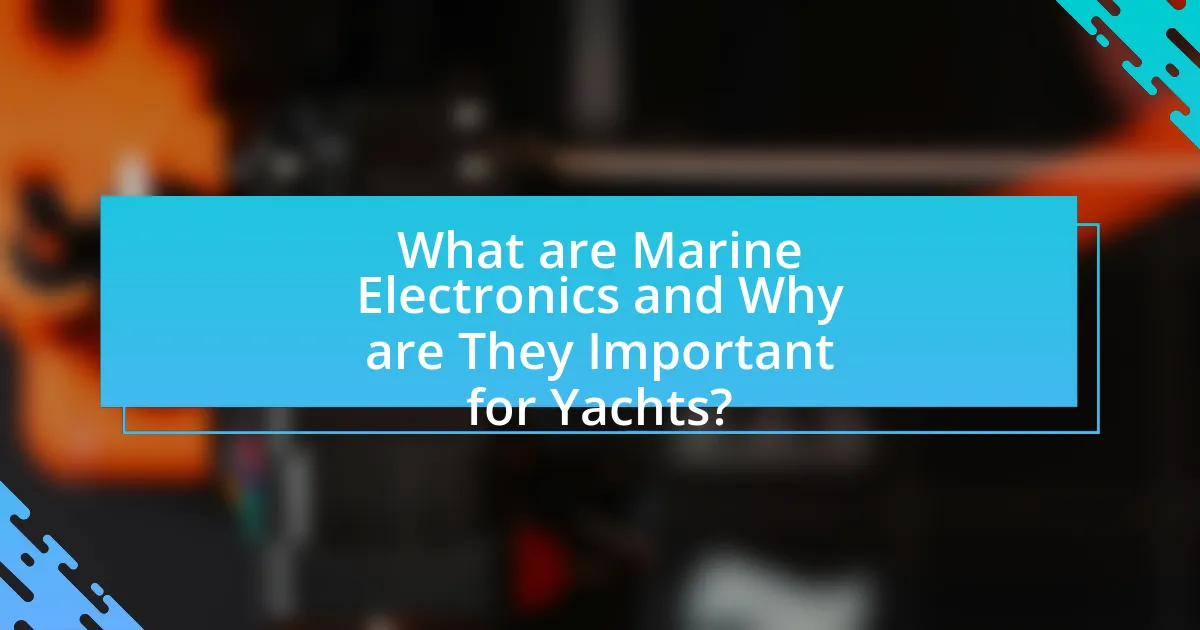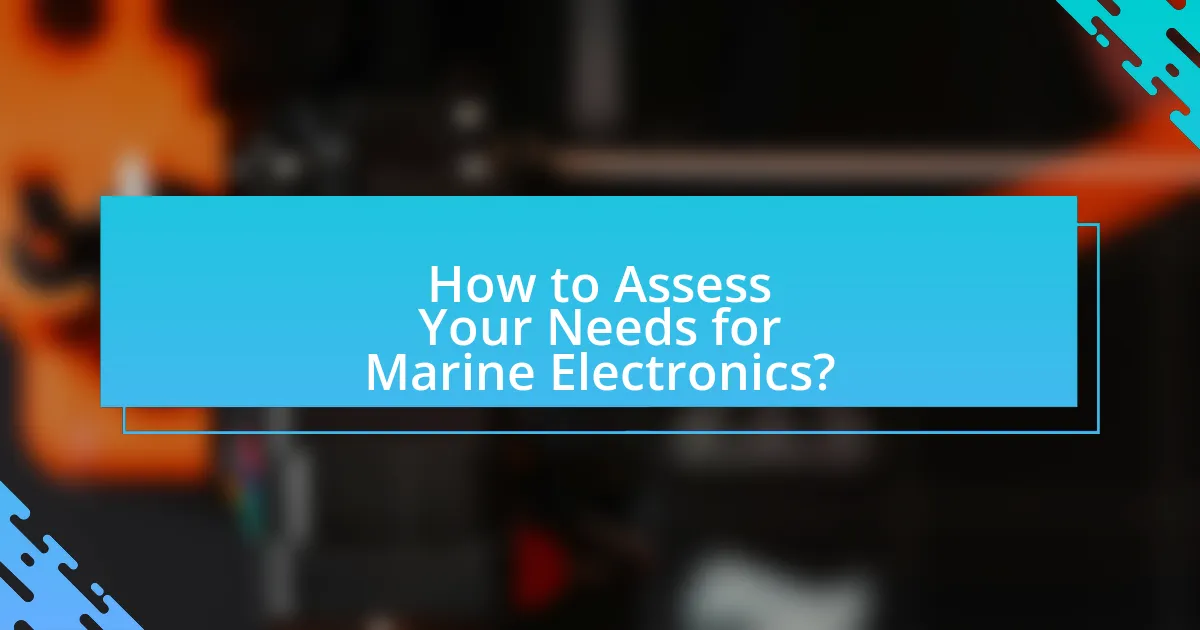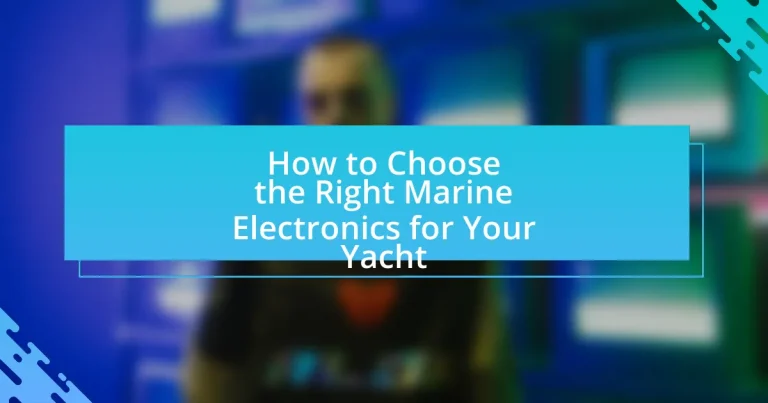Marine electronics are specialized devices and systems essential for navigation, communication, and safety on yachts. This article outlines the importance of marine electronics in enhancing safety and operational efficiency, detailing specific safety features such as GPS tracking, AIS, and VHF radios. It also categorizes essential marine electronics, discusses how to assess individual needs based on yacht size and cruising environment, and provides guidance on selecting reputable brands and models. Additionally, best practices for installation and maintenance are highlighted to ensure reliability and longevity of marine electronics.

What are Marine Electronics and Why are They Important for Yachts?
Marine electronics are specialized electronic devices and systems designed for use on boats and yachts, including navigation, communication, and safety equipment. They are crucial for yachts as they enhance safety by providing accurate navigation data, facilitate communication with other vessels and shore stations, and improve overall operational efficiency. For instance, GPS systems enable precise location tracking, while radar systems help detect obstacles and other vessels, significantly reducing the risk of accidents at sea. Additionally, marine electronics contribute to better weather monitoring, allowing yacht operators to make informed decisions regarding sailing conditions.
How do Marine Electronics enhance the safety of a yacht?
Marine electronics enhance the safety of a yacht by providing critical navigation, communication, and monitoring capabilities. Navigation systems, such as GPS and radar, allow for precise positioning and obstacle detection, reducing the risk of collisions and grounding. Communication devices, including VHF radios and satellite phones, ensure that yacht operators can maintain contact with emergency services and other vessels, facilitating timely assistance in emergencies. Monitoring systems, such as AIS (Automatic Identification System), track nearby vessels and their movements, further enhancing situational awareness. According to the U.S. Coast Guard, the use of AIS has significantly contributed to a reduction in maritime accidents by improving vessel tracking and communication.
What specific safety features should be considered in Marine Electronics?
Specific safety features to consider in marine electronics include GPS tracking, AIS (Automatic Identification System), VHF radio communication, and emergency position-indicating radio beacons (EPIRBs). GPS tracking provides real-time location data, enhancing navigation safety. AIS allows vessels to identify and track other ships, reducing collision risks. VHF radios facilitate reliable communication with other vessels and shore stations, crucial during emergencies. EPIRBs are essential for alerting rescue services in distress situations, significantly increasing survival chances. These features collectively enhance maritime safety by improving situational awareness and communication capabilities.
How do Marine Electronics contribute to navigation safety?
Marine electronics enhance navigation safety by providing accurate positioning, real-time data, and advanced communication systems. GPS technology, for instance, allows vessels to determine their precise location, reducing the risk of collisions and grounding. Additionally, radar systems detect nearby obstacles and other vessels, enabling timely decision-making. According to the U.S. Coast Guard, the integration of electronic navigation aids has significantly decreased maritime accidents, demonstrating their effectiveness in improving safety at sea.
What types of Marine Electronics are essential for yacht owners?
Essential marine electronics for yacht owners include GPS navigation systems, VHF radios, fish finders, autopilots, and chartplotters. GPS navigation systems provide accurate positioning and route planning, which is crucial for safe navigation. VHF radios facilitate communication with other vessels and shore stations, ensuring safety and coordination. Fish finders help locate fish and underwater structures, enhancing fishing experiences. Autopilots assist in maintaining a steady course, reducing the need for constant manual steering, which is particularly beneficial on long voyages. Chartplotters integrate GPS data with electronic charts, allowing for efficient route management and real-time navigation updates. These devices collectively enhance safety, navigation efficiency, and overall enjoyment for yacht owners.
What are the key categories of Marine Electronics?
The key categories of Marine Electronics include navigation systems, communication devices, safety equipment, and entertainment systems. Navigation systems encompass GPS, chartplotters, and radar, which are essential for route planning and situational awareness. Communication devices consist of VHF radios and satellite phones, crucial for maintaining contact with other vessels and shore stations. Safety equipment includes AIS (Automatic Identification System) and EPIRBs (Emergency Position Indicating Radio Beacons), which enhance safety during emergencies. Entertainment systems, such as audio and video equipment, provide leisure options on board. Each category plays a vital role in ensuring a safe and enjoyable experience while yachting.
How do different types of Marine Electronics serve various purposes?
Different types of marine electronics serve various purposes by enhancing navigation, communication, safety, and operational efficiency on the water. Navigation systems, such as GPS and chartplotters, provide real-time positioning and route planning, which are essential for safe travel. Communication devices, including VHF radios and satellite phones, facilitate contact with other vessels and shore stations, ensuring safety and coordination. Safety equipment, like AIS (Automatic Identification System) and radar, helps in collision avoidance and situational awareness, significantly reducing the risk of accidents. Additionally, fish finders and sonar systems assist in locating marine life, enhancing fishing efficiency. Each type of marine electronic is designed to fulfill specific operational needs, contributing to a comprehensive approach to maritime activities.

How to Assess Your Needs for Marine Electronics?
To assess your needs for marine electronics, start by evaluating your boating activities, such as cruising, fishing, or racing, as these will dictate the types of electronics required. For instance, a cruising yacht may need a reliable GPS and chartplotter, while a fishing vessel might prioritize sonar and fish finders.
Next, consider the size of your yacht and the available space for installation, as this will influence the size and number of devices you can accommodate. Additionally, assess your budget, as marine electronics can vary significantly in price, from basic models to advanced systems with multiple features.
Finally, research the latest technology and user reviews to ensure that the equipment you choose meets your specific needs and is compatible with existing systems on your yacht. This approach ensures that you select the most suitable marine electronics for your unique requirements.
What factors should you consider when choosing Marine Electronics?
When choosing marine electronics, consider compatibility, functionality, durability, and user interface. Compatibility ensures that devices work seamlessly together, which is crucial for integrated systems on a yacht. Functionality refers to the specific features needed for navigation, communication, and safety, such as GPS accuracy and radar capabilities. Durability is essential due to the harsh marine environment; devices should be waterproof and resistant to corrosion. Lastly, a user-friendly interface enhances usability, allowing for efficient operation while at sea. These factors collectively ensure that the marine electronics meet the operational demands and safety requirements of yacht navigation.
How does the size and type of your yacht influence your choice?
The size and type of your yacht significantly influence your choice of marine electronics by determining the compatibility, power requirements, and functionality of the equipment. Larger yachts typically require more advanced systems, such as integrated navigation and communication tools, due to their complex operations and longer voyages. For instance, a yacht over 50 feet often benefits from multi-function displays and autopilot systems, while smaller vessels may only need basic GPS and VHF radios. Additionally, the type of yacht, whether a sailing yacht or a motor yacht, affects the choice of electronics; sailing yachts may prioritize wind instruments and chart plotters, whereas motor yachts might focus on engine monitoring systems and radar. This differentiation ensures that the selected electronics enhance the yacht’s performance and safety, aligning with the specific needs dictated by its size and type.
What is your typical cruising environment and how does it affect your needs?
My typical cruising environment consists of coastal waters with varying weather conditions, which significantly influences my needs for marine electronics. In such environments, reliable navigation systems, weather forecasting tools, and communication devices are essential for safety and efficiency. For instance, coastal cruising often involves navigating through busy harbors and shallow waters, necessitating high-accuracy GPS and depth sounders to avoid hazards. Additionally, unpredictable weather patterns require access to real-time weather updates, making satellite communication systems vital for timely information. These specific requirements highlight the importance of selecting marine electronics that enhance safety and operational effectiveness in diverse cruising conditions.
How can you determine the best brands and models of Marine Electronics?
To determine the best brands and models of Marine Electronics, evaluate product reviews, expert recommendations, and user feedback. Research shows that brands like Garmin, Raymarine, and Simrad consistently receive high ratings for reliability and performance in marine electronics. For instance, a 2022 survey by the National Marine Electronics Association indicated that Garmin was the most preferred brand among boaters, with 85% satisfaction reported. Additionally, comparing specifications, warranty offerings, and customer service ratings can further guide the selection process.
What are the most reputable brands in the Marine Electronics market?
The most reputable brands in the Marine Electronics market include Garmin, Raymarine, Furuno, Simrad, and Lowrance. Garmin is known for its advanced GPS and chartplotting technology, while Raymarine offers a wide range of marine electronics, including radar and sonar systems. Furuno is recognized for its high-quality fish finders and navigation equipment, and Simrad specializes in multifunction displays and autopilot systems. Lowrance is well-regarded for its user-friendly fish finders and chartplotters. These brands have established their reputation through consistent innovation, reliability, and positive user feedback in the marine industry.
How do customer reviews and expert opinions guide your selection?
Customer reviews and expert opinions significantly influence the selection of marine electronics for yachts by providing real-world insights and professional evaluations. Customer reviews offer firsthand experiences regarding product performance, reliability, and usability, which can highlight potential issues or advantages that may not be evident in marketing materials. For instance, a study by BrightLocal in 2022 found that 87% of consumers read online reviews for local businesses, indicating the importance of peer feedback in decision-making. Expert opinions, often derived from extensive industry knowledge and testing, provide authoritative guidance on the best products available, helping to narrow down choices based on technical specifications and performance metrics. This combination of user feedback and expert analysis ensures a well-rounded approach to selecting marine electronics, ultimately leading to more informed purchasing decisions.

What are the Best Practices for Installing and Maintaining Marine Electronics?
The best practices for installing and maintaining marine electronics include ensuring proper installation, regular maintenance, and using quality components. Proper installation involves following manufacturer guidelines, securing connections to prevent corrosion, and ensuring devices are mounted in locations that minimize exposure to water and extreme temperatures. Regular maintenance includes checking connections, updating software, and cleaning devices to prevent buildup of salt and grime. Using quality components, such as marine-grade cables and connectors, enhances durability and performance, as these materials are designed to withstand harsh marine environments. Following these practices helps ensure the longevity and reliability of marine electronics.
How should you approach the installation of Marine Electronics?
To approach the installation of Marine Electronics, begin by carefully planning the layout and placement of each device to ensure optimal functionality and accessibility. This involves assessing the vessel’s design, considering factors such as power supply, cable routing, and potential interference from other equipment. Proper installation techniques, including secure mounting and waterproofing, are essential to maintain the integrity and performance of the electronics in a marine environment. According to the National Marine Electronics Association, following manufacturer guidelines and industry standards during installation significantly reduces the risk of equipment failure and enhances safety on board.
What are the common installation mistakes to avoid?
Common installation mistakes to avoid include improper wiring, neglecting to follow manufacturer instructions, and failing to secure connections adequately. Improper wiring can lead to electrical failures or hazards, as incorrect connections may cause short circuits. Neglecting manufacturer instructions often results in suboptimal performance or damage to the equipment, as specific guidelines are designed to ensure compatibility and functionality. Additionally, failing to secure connections can lead to corrosion or disconnection due to vibrations and movement on the yacht, which can compromise the reliability of the marine electronics.
How can you ensure proper wiring and connections for reliability?
To ensure proper wiring and connections for reliability, use high-quality marine-grade wiring and connectors specifically designed for harsh marine environments. Marine-grade materials resist corrosion, moisture, and UV exposure, which are critical factors in maintaining electrical integrity on a yacht. Additionally, follow the manufacturer’s specifications for wire gauge and connection methods to prevent overheating and ensure optimal performance. Regularly inspect connections for signs of wear or corrosion, as studies indicate that up to 30% of electrical failures in marine applications are due to poor connections.
What maintenance tips can prolong the life of your Marine Electronics?
To prolong the life of your marine electronics, regularly clean and inspect the devices, ensuring that connections are secure and free from corrosion. Marine electronics are exposed to harsh environments, so using protective covers and storing devices in dry, cool places when not in use can significantly reduce wear and tear. Additionally, updating software and firmware regularly helps maintain optimal performance and security. According to the National Marine Electronics Association, proper maintenance can extend the lifespan of marine electronics by up to 50%.
How often should you check and update your Marine Electronics?
You should check and update your marine electronics at least once a year. Regular annual checks ensure that software updates, firmware upgrades, and system diagnostics are performed, which can enhance performance and security. According to the National Marine Electronics Association, keeping marine electronics updated is crucial for optimal functionality and safety, as outdated systems may not perform reliably in critical situations.
What are the signs that your Marine Electronics may need repair or replacement?
Signs that your Marine Electronics may need repair or replacement include malfunctioning displays, inconsistent readings, and failure to power on. Malfunctioning displays can indicate internal issues, while inconsistent readings may suggest sensor problems or software malfunctions. Additionally, if devices fail to power on despite proper connections and power supply, it often signals a need for repair or replacement. Regular maintenance and monitoring of these signs can help ensure the reliability of marine electronics.
What are some common troubleshooting tips for Marine Electronics?
Common troubleshooting tips for marine electronics include checking power connections, ensuring proper grounding, and verifying software updates. Power connections should be inspected for corrosion or loose wires, as these can disrupt functionality. Proper grounding is essential for reducing electrical noise and ensuring reliable operation. Additionally, keeping software updated can resolve bugs and improve performance, as manufacturers often release updates to enhance device capabilities. Regularly consulting the user manual can also provide specific troubleshooting steps tailored to individual devices.















